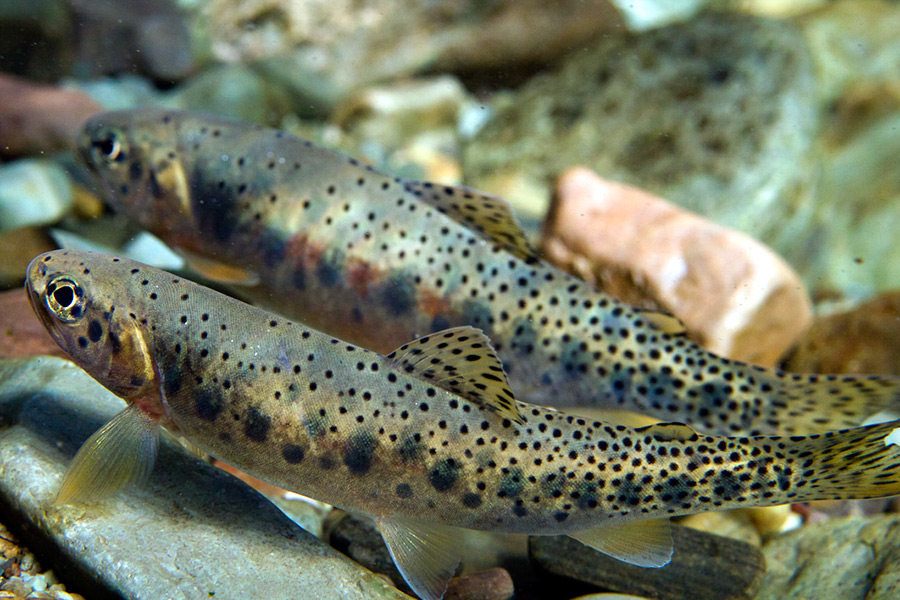Even as fisheries managers work to reverse the damaging effects of legacy stocking of nonnative species, interbreeding between native and invasive trout continues to increase in parts of the northern Rocky Mountains, exacerbated by climate change and other human stressors, according to an unprecedented study published this month by the U.S. Geological Survey.
When native trout like Montana’s iconic state fish, the westslope cutthroat, interbreed with invasive rainbow trout, they lose local genetic adaptations, which can ultimately end up threatening the species’ long-term survival. Equipped with drainage-specific genetic markers they’ve adopted over the course of millennia, native cutthroat trout lose those important traits as their genetics become diluted.
Protecting and maintaining the genetic integrity of the native species is critical to ensure its resilience and allow it to better adapt to a sudden change in new environmental conditions, according to researchers.
“Cutthroat trout are still here on the landscape and they are adapting to persist, so there is actually good news here,” Clint Muhlfeld, aquatic ecologist for the USGS Northern Rocky Mountains Science Center, said. “There is actually good news here. But we have to proactively implement effective conservation programs to maintain and restore that genetic diversity across the landscape.”
While regional programs are beginning to show success in propping up native populations of cutthroat and driving down hybridization, human stressors and a warming world present a host of challenges for fisheries managers.
The study found that hybridization is increasing over a broad geographic region despite fisheries managers having curtailed stocking practices nearly 40 years ago. Data going back to the 1980s show that 50 percent of sites with long-term data have experienced increases in hybridization, the majority of which initially held genetically pure populations of cutthroat.
To grasp the scope of interbreeding, and the pace at which it continues to erode genetically pure populations, a team of researchers led by Muhlfeld culled data from one of the most comprehensive long-term genetic monitoring programs worldwide, showing that widespread introductions of invasive rainbow trout and recent variations in the climate were associated with the spread of hybridization in native westslope cutthroat trout populations across the United States’ northern Rocky Mountains.
The University of Montana Conservation Genetics Laboratory, which Muhlfeld said has long been a pioneer in the fields of genetics and genomics, processed all the samples, meaning the researchers could track all their genetic information at one lab.
The spread of hybridization was primarily driven by historical stocking practices combined with warmer water temperatures, as well as higher road densities and lower spring precipitation.
“Our results show that climatic changes are interacting with legacies of rainbow trout introduction and habitat degradation to threaten native cutthroat trout, as invasive rainbow trout continue to expand their range across the northern Rockies,” Muhlfeld said. “The loss of native genomes from hybridization is a scenario being realized currently and one that will only proceed into the future, representing a critical threat to native trout persistence.”
Muhlfeld and his colleagues used genetic information captured from 12,878 individual fish caught at 582 locations in 17 river basins and three major continental river drainages — the Columbia, Missouri and South Saskatchewan — between 1980 and 2015, and examined detailed historical stocking records from 1924 to 1980 for approximately 200 million introduced rainbow trout.
“It is truly an amazing database, and I am fortunate and honored to be working with it,” Muhlfeld said. “It really underscores the fact that our biologists have been ahead of the curve.”
Although streams with warmer water temperatures were more prone to hybridization, most hybridized sites (approximately 60 percent) had cold mean summer water temperatures, countering the notion that cold headwater streams serves as a refuge that prevent hybridization.
“Our data clearly show that cold headwater streams are not immune to rainbow trout invasion and hybridization with native cutthroat trout, especially those in close proximity to historical stocking sites,” Muhlfeld said. “Conservation strategies based solely on temperature criteria may seriously underestimate the threat of rainbow trout invasion and hybridization with native trout populations in headwater streams.”
Hybridization between native and nonnative species is likely to increase in the coming years due to climate-induced expansions of invasive species, according to the study, published in “Global Change Biology.”
Conservation strategies that mitigate existing human stressors, such as translocation of species and habitat modification that interact with climate to promote the expansion of invasive species, will be crucial for conserving biodiversity and preventing genomic extinction of additional populations and eventually entire lineages of native cutthroat trout, Muhlfeld said.
In Northwest Montana, fisheries managers have spent decades working to repair the harmful effects of legacy stocking while fine tuning the interplay between science-based manipulation and nature in order to protect one of the last remaining strongholds of cutthroats in the lower 48.
Massive, landscape-scale conservation efforts are in the works, including translocation of native species, drainage-specific stocking, eradication of invasive species, and rearing of genetically pure trout.
Working in concert, management agencies and researchers are developing a clearer understanding of the trout’s evolutionary history, overall genetic diversity, conservation challenges, and reproductive success.
“This research shows that human activities can have long-lasting and increasingly synergistic impacts on biodiversity, including species of recreational value like native trout,” co-author and USGS scientist Ryan Kovach said.
“The cool thing about Montana is it represents the last of the best,” Muhlfeld added. “We still have the full expression of genetic diversity distributed across the landscape.”
